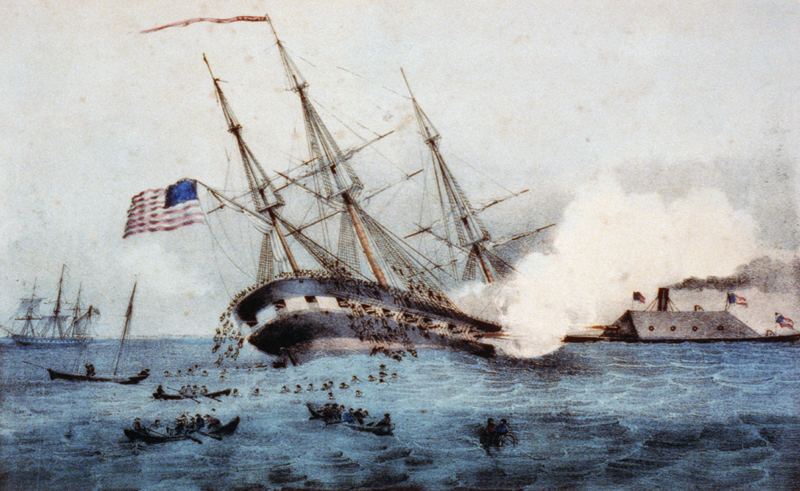Hero Tales: Really Authentic
 We all love the director’s commentary and the extra “How We Made It” sequences on DVDs. We’re not quite there yet for our own Great Waters Press productions, but we thought you might be interested in what is going into our Hero Tales audiobook CDs.
We all love the director’s commentary and the extra “How We Made It” sequences on DVDs. We’re not quite there yet for our own Great Waters Press productions, but we thought you might be interested in what is going into our Hero Tales audiobook CDs.
The third volume in this series brings the collection up to the War Between the States. One track tells the story of the 1862 Battle of Hampton Roads, between the USS Monitor and the CSS Virginia (often called the Merrimac), the first clash of ironclad warships.
This was an interesting story to produce. We’ve used the sounds of waves, seagulls, and ship’s bells before to give the basic nautical flavor to the background. But the Monitor and the Virginia offer unique problems. To start with, what did they sound like when they were underway?
We try to be as authentic as possible with the sound effects in these stories, but sometimes you just have to make your best educated estimate. For instance, we know both these ships were propeller driven, so we can’t use sternwheel riverboat sounds. They were steam powered vessels with engines peculiar to maritime uses. While there’s information online about the different styles of engine they used, I couldn’t find any recordings of that exact machinery. I opted to use the sound of two different narrow gauge steam locomotives, one a little deeper and slower than the other, edited to give the steady beat you would have heard on board.
One of the remarkable features of the battle was the sight of cannonballs bouncing off the ironclad vessels. Did that make a distinctive sound? I think so, and I think it would have been distinct for the two warships. The armor on the two vessels was radically different. The Virginia had four inches of iron on top of 24 inches of solid oak and pine. The Monitor, on the other hand, was all metal – the most exposed thing, the gun turret, had eight 1-inch layers of iron bolted together, with another layer of 1-inch plates bolted inside the turret to dampen the sound of a direct hit (yeah, right). I chose a deep metallic sound for ricochets off the Virginia, sort of a “bong,” and a higher note (“clank”) for hits on the Monitor.
Their guns were different, too. The Monitor had two big 11-inch naval guns, while the Virginia was described as a floating battery – smaller guns, but lots of them. I found a recording of an actual Civil War cannon shot, likely a smaller bore field piece, which I used for the Virginia’s rifled armaments. A deeper “boom” stands in for the Monitor’s big Dahlgrens..
If you listen carefully to the battle sequences, you might be able to track who’s shooting what at whom—and watching it bounce harmlessly off which.
Maybe the most interesting sound occurs at the celebration on the southern shore after the Virginia’s initial success. We were struggling to figure out what that must have sounded like when my son John Calvin found a recording (a film, actually) made at one of the last reunions of Civil War veterans in the 1930’s. The three cheers you hear echoing over Chesapeake Bay on our CD are rebel yells performed by Confederate veterans at that reunion. It sounds quite different than you might expect. How authentic is that?
Sometimes you just can’t find what you need. I’ve already mentioned the creepy Deguello bugle call Santa Anna used to announce “No prisoners” to the defenders of the Alamo. Our army never had need of it, and I couldn’t find another recording suitable for use. Roosevelt didn’t mention the bugle, so I just let that historical detail pass. The shots from Jim Travis’ pistol are a period black-powder revolver, though, and the ticking clock on Gouveneur Morris’ wall in revolutionary Paris is an 18th-century, Scottish antique – and the angry mob in the street is shouting in French. That’s in volume 2, by the way.
If you have enjoyed our rendition of Hero Tales, we’ll be glad to answer any questions we can. If you haven’t heard them yet, why not download a sample and try one out? We think you’ll like them! Download them, order them, or learn more by clicking here.
Bibliography Note: When the book Hero Tales from American History was first published in 1895, Henry Cabot Lodge got top billing over co-author Theodore Roosevelt. Although both men were Harvard graduates with established records of historical and biographical books, at that time Lodge was the more prominent of the two—a Ph.D serving in the U.S. Senate after three terms in the House. Roosevelt had served short terms in the New York General Assembly and the federal Civil Service Commission, but his meteoric rise from the New York governor’s office to the White House (with a brief visit to San Juan Hill, Puerto Rico) were still in his future. So in 1895, Senator Lodge is credited first.